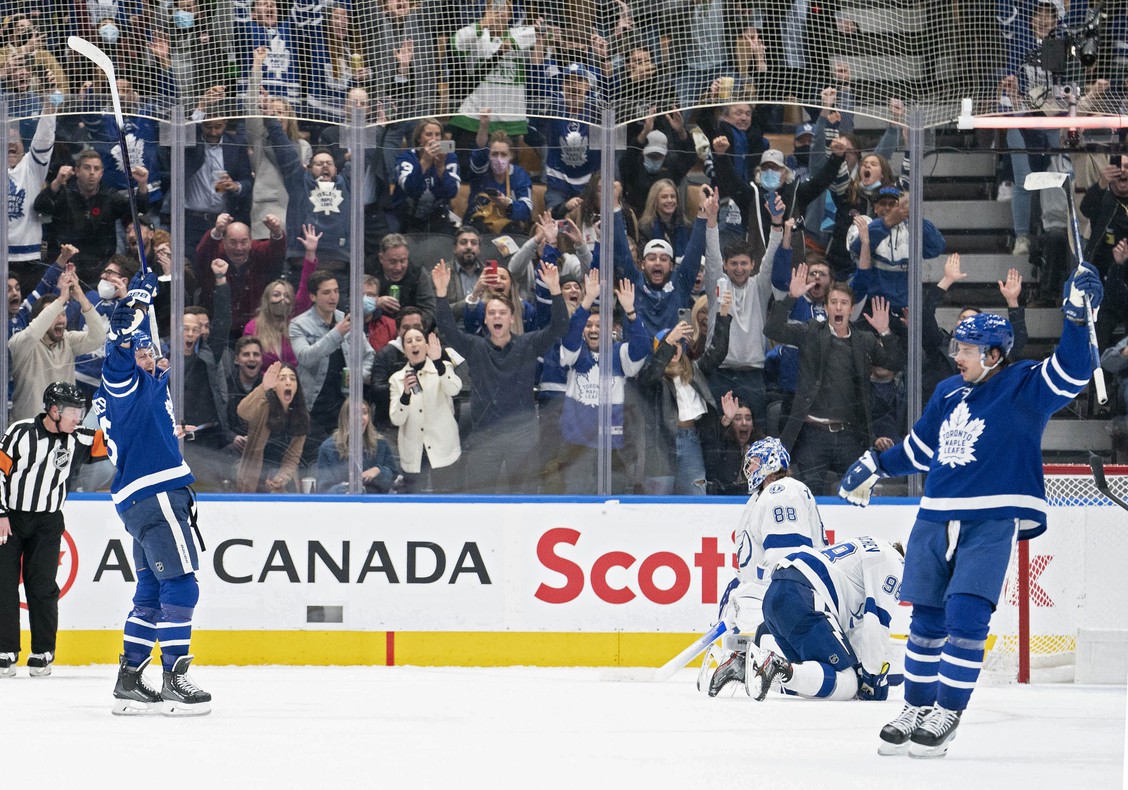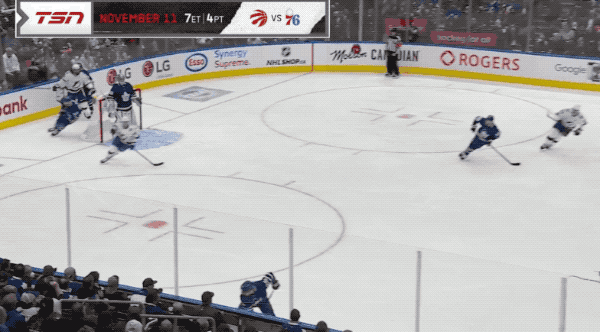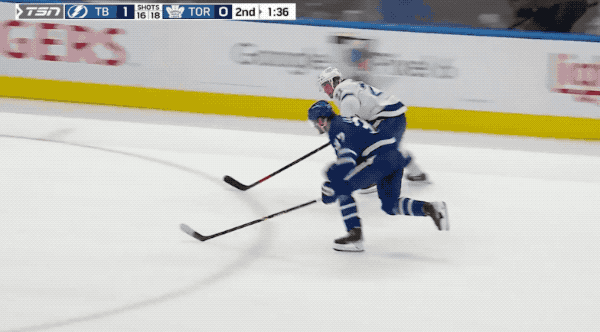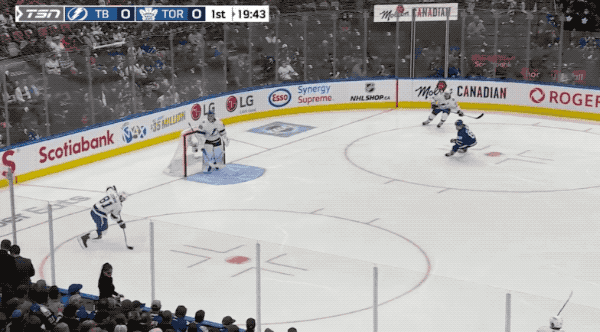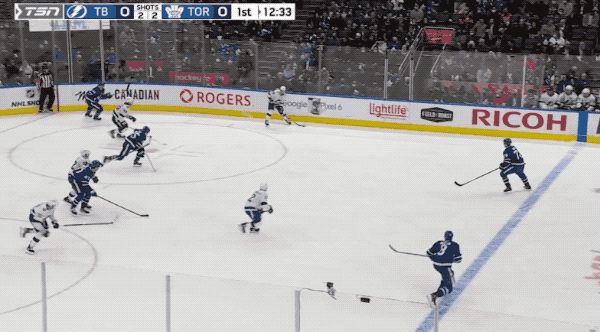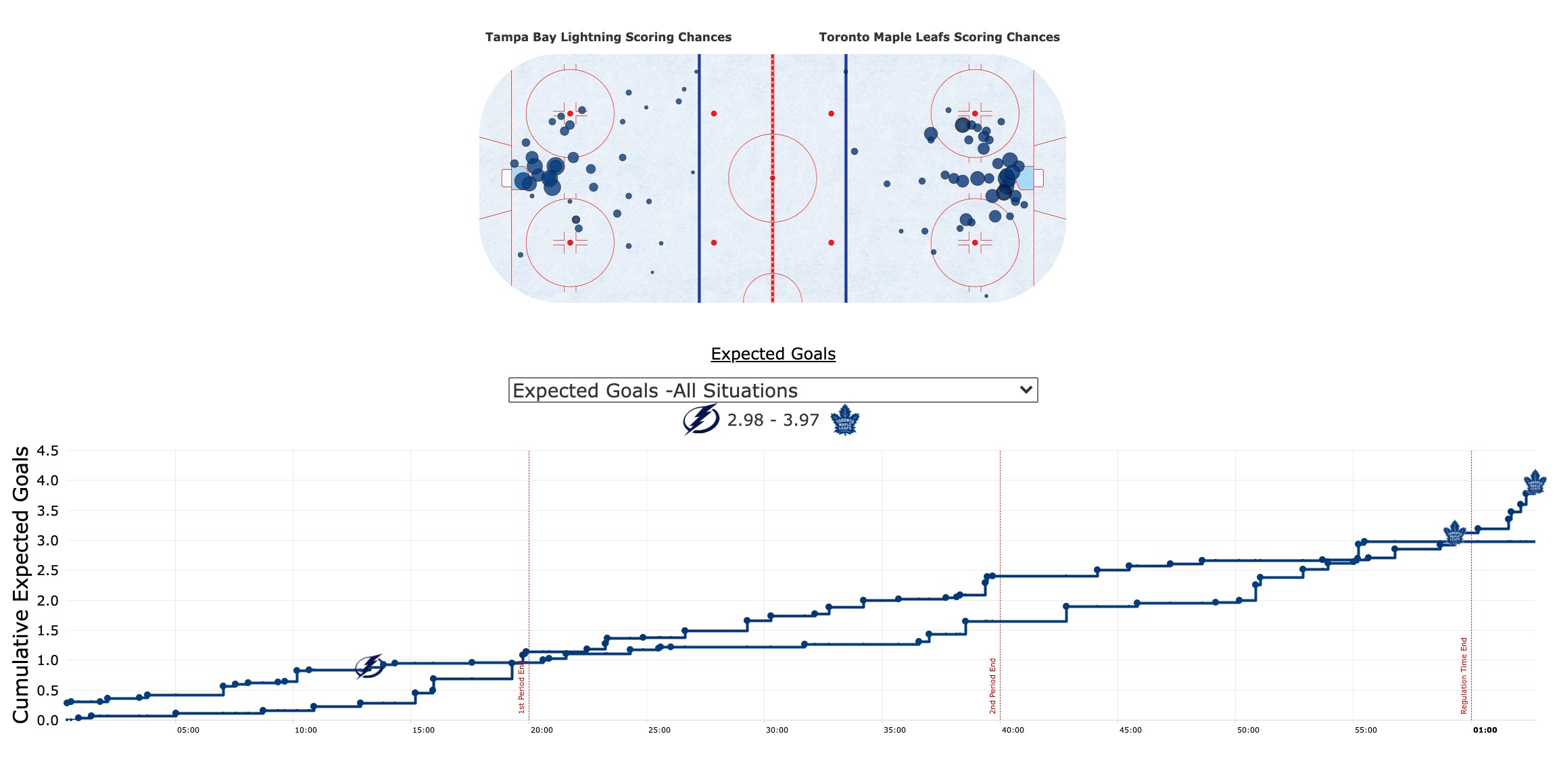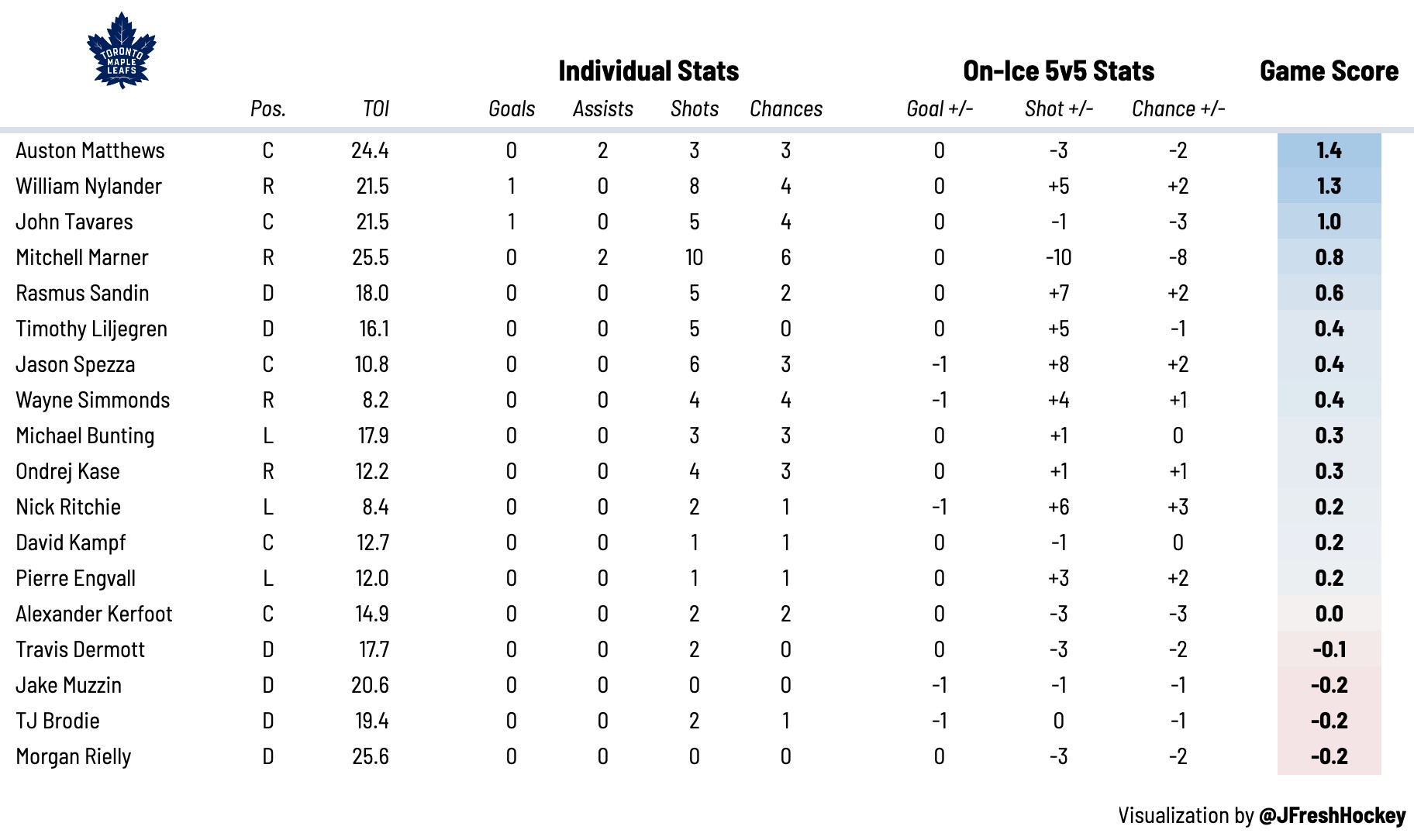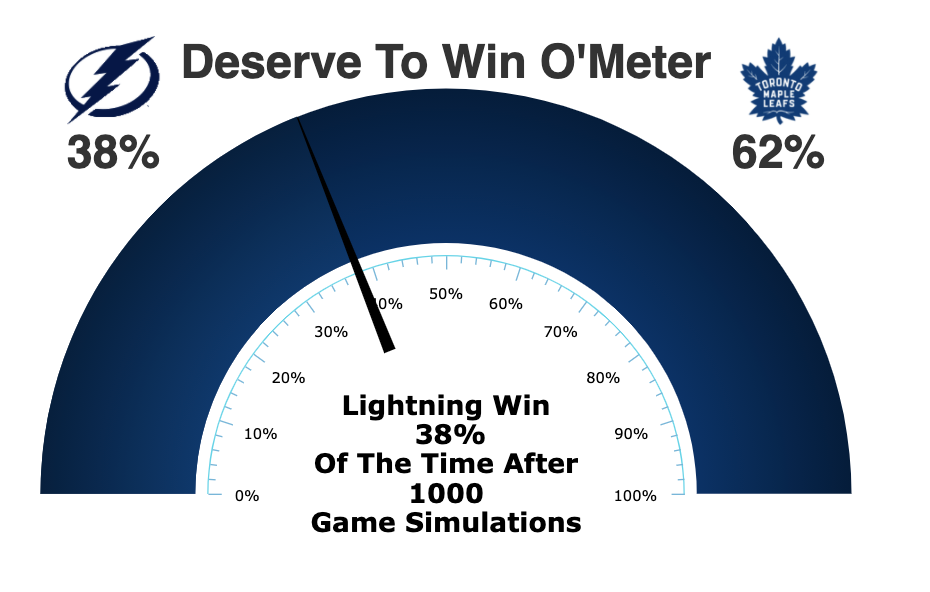Well, that was certainly entertaining!
Toronto defeated Tampa Bay by a final score of 2-1, but that doesn’t even begin to tell you the story of this game.
The Leafs actually started out really slow on Thursday night, allowing multiple rush chances to the Lightning. In contrast, Toronto’s buildup play was much slower, which is something Sheldon Keefe & co. have been trying to fix all season. He wants the team playing faster at 5v5, making quick passes up the ice to get their talented forwards into open ice off the rush.
That didn’t happen tonight, which is a big part of the reason the Leafs‘ highly paid “Core Four” struggled to generate much of anything — until there were 41 seconds remaining in the game. John Tavares ended up tying the game off of a pass from Mitch Marner, while Nylander scored the game-winner on a 4v3 power play thanks to a cross-seam pass from Auston Matthews.
That wasn’t the theme of the game through 59 minutes, which is the portion we’ll spend the majority of our time analyzing. I’m a large sample kind of guy, after all, so let’s focus on the larger portion of the game here.
It’s time for some Leafs Report Cards!
5 Stars
Jack Campbell (G, #36) — He and Andrei Vasilevskiy absolutely stole the show tonight. Heading into overtime, the score should’ve been 3-3 based on the quality of chances both teams were generating (according to Moneypuck.com). Instead, the score was 1-1 after 60 minutes, with each goaltender stealing their team two goals a piece.
We’re talking one-timers, east-west passes, 2-on-1s, rebounds, breakaways — all high-percentage chances. My favourite Jack Campbell save was this one on Brayden Point, who also had himself a game tonight.
Campbell pushing off and getting across left-to-right (and vice versa) was a major theme tonight. He’s the main reason Toronto was able to stay in this game, although the Sh% Gods could’ve given him a bit more goal support.
TJ Brodie (LD, #78) — This was his best performance of the season by far.
His partner had another nightmare game, which we’ll get to at the end, but let’s focus on Brodie’s individual play. His rush defense was excellent, maintaining a solid gap in the neutral zone and closing the space before Tampa’s skilled forwards could gain the zone. That’s the Brodie we all remember.
He also made some confident plays with the puck on his stick, which has been a rarity for him early in the season. His breakouts looked smooth for the most part, making crisp passes up the ice, and he even activated into the play a few times to help Toronto create some chances off the rush, which have been sorely lacking at 5v5 this season. He even joined the party at 4v5, hopping up in the play with Ondrej Kase to provide a bit of “Power Kill” offense.
Brodie’s confidence with the puck is an excellent step in the right direction, but even more importantly, his transition defense looked as stellar tonight as it did last season. That’s the reason he’s earning $5 million per season and he looked well worth the money in this game.
4 Stars
The Fourth Line — It’s never a great sign when your fourth line is your best line for the majority of the game. That says a lot more about the top-end players, who we’ll definitely be discussing later on.
For now, I wanted to focus on how great Nick Ritchie looked off the rush, which feels weird to type out. It’s not an area of the game where you’d expect the 240-pounder to thrive, but he made a pair of excellent passes to get the puck across to his linemate on 2-on-1s. Those pucks didn’t go in, but there isn’t a higher percentage play in hockey.
The other crease-crasher on the line, Wayne Simmonds, managed to get himself a few Grade-A chances. One of those came on an aforementioned 2-on-1 with Ritchie, where Simmonds was robbed by Vasilevskiy. The other was a forehand-backhand move on a breakaway, where Simmonds was once again, robbed by Vasilevskiy.
As frustrating as it can be when a player isn’t converting on their chances, it’s worth noting that Simmonds has been generating quality scoring opportunities at a career-high rate 10 games into the season. For a bit of context, Simmonds’ has averaged 0.72 “expected” goals per 60 minutes throughout his career. Throughout his prime years in Philadelphia, he hovered around the 0.8 mark.
He’s at 1.45 expected goals per 60 this season, which ranks second in the NHL right now. It’s unlikely to stay that high, but the fact that he’s getting so many chances close to the net indicates that the goals are going to come.
With respect to Jason Spezza, I weirdly thought he was the least impressive player on his line. That’s okay; good players have off-nights. He just didn’t look very dangerous tonight compared to his usual standards, and he cost his team defensively by blowing a few assignments defensively for odd-man rushes against.
The Sandin-Liljegren Pair — Poor Justin Holl must be having Mike Babcock flashbacks. He’s probably sitting for at least another game now that Timothy Liljegren is playing some of the best hockey of his life. I’ve been tracking his development for a long time and this is the most confident I’ve ever seen him look in the offensive zone.
It’s funny because the offensive side of his game is where I’ve been the most underwhelmed over the years, but Liljegren has looked great walking the line at 5v5 and staying in motion to get himself open without the puck. This is also an area where Rasmus Sandin excels, using his agility to lose his man in DZ coverage and hop into the open ice.
Speaking of confidence, check out this move from Sandin.
He’s dynamic with the puck despite not having the top-end speed you’d expect from a blue-chip prospect.
Watching his shifts in the offensive zone alongside Toronto’s top-six talent is my favourite part of analyzing Leafs games these days. With his ability to read the game and complete passes an elite level, they should find a way to get him out there with quality finishers more often.
3 Stars
Ondrej Kase (RW, #25) — His linemates didn’t give him much help tonight, but Kase still managed to make some things happen offensively with his speed. I’d love to see him alongside someone who could actually get him the puck since he has a knack for finding open patches of ice in dangerous areas.
Justin Holl (RD, #3) — Loved his positioning tonight. Never saw him blow an assignment once.
The Core Four™
So here’s the thing, the boxcar stats look solid for each of these forwards. If you had them in fantasy, you’re probably feeling pretty good right now. If you watched them get outplayed for 59 minutes, I’m guessing you feel less good.
When Mitch Marner was on the ice at 5v5, the Leafs allowed 13 chances from the slot and only generated five. He split time with Matthews and Tavares, so there’s one clear independent variable here. What’s frustrating is that he looked amazing on the 4v3 power play in overtime running things from the top. He’s clearly an elite talent, but lately he hasn’t been able to dictate play at 5v5 against strong defensive teams.
Frankly, I had a similar assessment on the other three. John Tavares was largely irrelevant until there were 41 seconds left. I try to take rigorous notes throughout the game and I still had nothing on Tavares after two periods. But his last-minute finish from in tight was a big moment for the Leafs captain to step up.
Auston Matthews also had a largely disappointing night, failing to get himself into good shooting positions. We’re used to seeing Matthews force his way into the dangerous areas of the ice with his combination of size, speed and skill. He just wasn’t able to slice through the defense tonight, but he did thread the pass for the game-winning goal on the power play in OT.
Last but not least, William Nylander had me shouting at my screen tonight — for good and bad reasons. On the plus side, he was Toronto’s only skater (other than maybe Kase) who was able to generate chances off the rush tonight, which is a growing concern for the team this season. His fifth goal of the year was his third game winner of this young season.
On the other hand, he also gave up on a few plays defensively, which resulted in quality chances against.
You can’t fly by a guy with a Conn Smythe. I’ve always been a huge fan of Nylander’s talent — his one-timer on the 4v3 tonight is why I still think he should be stapled to the half-wall on the power play — but bad habits like these are the reason he’s built up a reputation among his detractors.
Stop giving these people a reason to post unfunny comments about you on Facebook. We all know how dominant you can be when you’re engaged.
2 Stars
Are We Sure They Played Tonight?
David Kampf (C, #64) — His entire role as a player is to make you ask this question, so maybe this is an unfair grade for Kampf. Then again, you have to generate offense at some point as an NHL forward, especially if you’re going to be eating 3C minutes. The Leafs clearly think there’s more Kampf can provide more offensively, and I certainly hope he can, because he’s been an absolute zero in that department this season. The box score shows that he won three of five draws but also took a trip to the penalty box in the first period.
Alex Kerfoot (LW, #15) — I spent way too much time tonight trying to figure “what does Alex Kerfoot…do?” Kyle Dubas obviously sees something in him that I don’t, so I tried my best to run down a checklist of things you’d expect from a top-six forward.
- He doesn’t shoot much
- He doesn’t get to the “inside”
- He doesn’t win very many 50-50 battles along the boards
- He doesn’t cover as the F3 nearly as often as he should
He does, however, kill penalties quite well. That’s a replaceable attribute, but it’s worth noting how well he does to “funnel” the puck to where he wants it to go. What I mean by that is he applies pressure well on the PK and forces the opposing PP to make passes around the perimiter rather than through the seam.
Is that worth $3.5 million? Absolutely not, but his speed does at least have some value.
Pierre Engvall (LW, #47) — These are the kind of games that frustrate the coach. Engvall was lethargic in 50-50 puck battles, underwhelming offensively, and frankly, unnoticeable for the majority of the game, and not in a good way.
Michael Bunting (LW, #58) — Okay, so this is cheating. We’re all very well aware that Bunting played this game — he’s hard to miss — but he committed some turnovers in the neutral zone. I know he isn’t William Nylander in transition, but you’d like to see him make smarter decisions with the puck.
He was conceding possession back to the opposition far too often. I love his hustle — how can you not!? — but he needs to manage the puck better when there are options available to him.
The Rielly-Dermott Pair — It’s early, but this pairing just hasn’t worked so far. In their 45 minutes together at 5v5, they’ve been getting outshot (47%) and out-chanced (46%). When you compare that to the Rielly-Brodie pair’s results in 123 minutes together, it’s night and day (56% and 53% respectively).
Morgan Rielly is getting buried when he plays alongside Travis Dermott, but not Brodie — even the version of him that’s really struggled 10 games into the season. One theory is that Dermott’s hyper-aggressiveness leaves the pairing exposed to rush chances against, whereas Brodie’s more patient approach gives Rielly and the forwards more time to get back and take away plays through the middle of the ice.
Here’s a quick example of how things can go wrong for Rielly-Dermott.
Now, 45 minutes isn’t a large enough sample to make an evaluation on a pairing, but it isn’t nothing, either. Let’s keep an eye on how things go moving forward.
Jake Muzzin (LD, #8) — Skating has never been Muzzin’s speciality, but rush defense has. Despite his limited foot speed, he’s always had a knack for closing the gap at the blueline and preventing opposing forwards from gaining the zone.
That hasn’t been happening very often this season and it’s quite concerning.
The Muzzin I know kills that play in the neutral zone. This year’s version is conceding the blueline and giving Steven Stamkos far too much room to get his shot off.
By now, I’m sure you’ve seen the blooper of Muzzin turning the puck over in the OZ, failing to get back in time to prevent the 2-on-1, and catapulting himself face-first into the crossbar after the goal horn went off. It’s very meme-able material. Personally, I could care less about one bad sequence, but the fact that he’s struggled night after night is a worrying trend.
Are we sure Muzzin is 100% recovered from the injury he suffered in the playoffs? We don’t know enough to say from the outside, but a night off seems like the logical thing to do if this is the case.
Heat Map
Here’s a quick look at where each team’s shots were coming from at even strength, courtesy of Natural Stat Trick.
At 5v5, the Leafs got outshot (48%) and out-chanced (43%) by the Lightning. When you take all situations into account, though, things look much better.
I still can’t believe it was 1-1 heading into overtime.
Game Score
Game score is a metric developed by The Athletic’s Dom Luszczyszyn to measure single-game performance. You can read more about it here.
Marner’s stat line is one of the most bizarre ones I’ve seen in a while.
Tweets of the Night
wow no credit to the team that won the deserve to win o meter https://t.co/lE4ezvNexV
— J (@Account4hockey) November 5, 2021
Put some respect on Moneypuck’s name, Mr. Cooper.
Based on the chances that were generated by both teams, if we replayed this game 1000 times, Toronto would win 62% of the time. I’m bringing this up after a win because I know how much everyone just loves seeing these graphics after a loss.
Marner setting up goals while standing below the goal line with a man advantage 👀👀
— Anthony Petrielli (@APetrielli) November 5, 2021
He’s at his best from non-shooting positions. I love him as a distributor both:
a) Below the goal line, and
b) Quarterbacking things from the point
Just finished my article about how Keefe and Marner aren’t any good and,
— Chemmy (@felixpotvin) November 5, 2021
Oh, the joys of writing a postgame column.















![John Gruden after the Leafs prospects’ 4-1 win over Montreal: “[Vyacheslav Peksa] looked really comfortable in the net… We wouldn’t have won without him” John Gruden, head coach of the Toronto Marlies](https://mapleleafshotstove.com/wp-content/uploads/2025/09/gruden-post-game-sep-14-218x150.jpg)








